Résumé
L’an dernier, dans le cadre du festival Sight & Sound, Eastern Bloc invitait l’artiste suisse Valentina Vuksic à présenter Tripping Through Runtime. Son oeuvre explore les possibilités offertes par le hacking ou la médiation de logiciels et d’équipement informatique. Sa performance ainsi que son atelier, tous deux partie prenante du festival que j’ai co-organisé, étaient profondément touchants et abordaient directement les problématiques du hacking investiguées à l’intérieur de ce numéro de .dpi. En plus de défier la matière physique pour produire une esthétique sonore à la fois indigène et étrangère à son oeuvre, les performances de Vuksic intègrent l’articulation de sa pensée autour des notions de visibilité et d'invisibilité et d’espaces que nous habitons. Je tenais à discuter avec elle de sa pratique artistique et des manières particulières de boguer et de déboguer le système, l’ordinateur et le domaine de la performance artistique sonore et numérique presque entièrement dominé par les hommes.
Vuksic creates the conditions necessary for the work to exist, she manipulates the electromagnet output to create interesting results. This has some resonance (pun intended) for me in thinking about the ways in which we organize as a feminist collective. It's not enough to observe the socio-political climate. Rather, you need to somehow engage with the processes that are already at play.

What is it that you do, in your own words. What are you trying to show/tell about your practice and to an audience?
I approach software and computers with pickups that capture the electromagnetic smog that surrounds electrical devices. In the case of the computer, many processes are running concurrently -- partly in the background, partly triggered by a user and visible on the screen. While they are processed, they alternate the power flow on the motherboard and its components, e.g. the graphic card, processor, memory, and produce changes in the radiated fields. The electromagnetic emissions can be converted to an acoustical signal and listened to. Only emissions in the human audible range are recognized though.
I want to make an environment that hosts computer processes and makes them accessible in a non-analytical way and is enjoyable in its variety of sound structures, patterns and irregularities, in its spheric and harsh sounds. In the long term, I am interested in what could be read from the electromagnetic signature of operating systems and software. Not necessarily in the sense of reverse engineering, but rather, aspects of programming techniques and cultures.
An idle operating system can also sound interesting. It has some background processes running, which might create meditative rhythms without any user action. I can further manipulate the electromagnetic output in the way I use the computer. Which operating system is used, which programs are running and moving the mouse all effect the sound. Different computers sound different as well, so I try out various things and rehearse “playing” it. In performance I either improvise or follow a choreography of user actions or run automatic programs to create the sounds.
How much is the audience relevant to your work?
The audience is invited to imagine this other level of reality, if I may call it that. I myself find the thought intriguing, that all sounds and occurring patterns are side effects of the engineering process of hardware and software developers. A problematic issue is the amount of hints given, by showing the computer screens alongside the sounds, which might draw the attention too far away from the sound. Besides, it's not expensive and rather easy to pick up the emissions oneself. I constantly wonder how much information an audience needs to follow along with the sounds. Some people would like to see the screen always, others feel distracted by it. The equipment is simple, therefore it's not a big effort in listening to your own computer. What is a little more difficult is reducing some of the constant noise, which might cover more interesting sounds underneath.

Do you consider your practice political?
I would be interested to consider production conditions and hardware/software design strategies when investigating electromagnetic emissions. But I haven't found a starting point yet. It's possible to reverse the captured signals back to the source, to find out which keys have been typed and even which machine instructions have been calculated (see http://tau.ac.il/~tromer/acoustic). Maybe it's possible then to find clues in the EM fields about guidelines that have been applied in the software development, for example, or if many or few developers were involved. What's the difference between a Linux, a Windows and a Mac? What about motherboards developed in China or Taiwan?
Interview conducted over email between Amber Berson and Valentina Vuksic over several weeks between February and March 2013.
Crédits images
Valentina Vuksic, Tripping Through Runtime, 2012, Montréal. Photo : Justin Desforges. Permission de : Eastern Bloc.
Valentina Vuksic est artiste dont le medium est l'ordinateur. Elle vit à Zürich. Son travail est une exploration personnelle des possibilités apportées par la médiation de l'articulation du logiciel et de la machine. Son approche est orientée vers les systèmes d'ordinateur à travers les microphones inductifs, soi-disant des « adaptateurs de téléphone ». Par des chorégraphies pour des logiciels et des éléments d'ordinateur, elle les utilise en tant qu'acteurs dans des pièces de « noise », pour, et dans les ordinateurs. Vuksic considère le temps et l'espace du processeur et de la mémoire de l'ordinateur comme des niveaux de réalité. L'exécution de logiciel crée ses propres dimensions temporelles et spatiales, qui sont mises en scène pour le public. Elle cherche à créer une expérience sensuelle de la sphère devenant concrète, là où la logique rencontre le monde physique. Les bruits mécaniques servent de médiateurs pour le public. Ils révèlent d'une manière immédiate les activités prenant place entre les exécutions de l'ordinateur, dans le sens le plus large, et les composants électroniques de l'ordinateur sur lesquels ils s'exécutent.
Amber Berson est passionnée d'art et de son potentiel à mener au changement social. Ses recherches actuelles focalisent sur l'art et le deuil, les pratiques muséales, la théorie narrative, la culture des centres d’artistes autogérés, la mythologie de l'art national et les collections vernaculaires. Son mémoire de maîtrise, exécuté à l'Université Concordia, examinait la façon dont les femmes autochtones, disparues et assassinées, ont été représentées dans l'art canadien. Elle travaille pour et en collaboration avec les centres d'artistes autogérés. Plus récemment, elle a agit à titre de commissaire à Eastern Bloc dans le cadre de plusieurs éditions du festival SIGHT & SOUND, de la série Salon : Data, de l’exposition Département des nuisances publiques et d'autres projets. Elle a aussi été commissaire de la résidence The Wild Bush dans un chalet à Val David; de In Your Footsteps à la Galerie VAV à l’Université Concordia, de The Magpies Nest au Homestead Wenger (Pennsylvanie) et de We lived on a map… présenté au CEREV (Centre for Ethnographic Research and Exhibition in the Aftermath of Violence) à Montréal. Elle a aidé à la coordination du Registre Courtepointe Québec, à l’organisation des archives picturales de Guido Molinari, à la recherche de vêtements métis dans les collections européennes et veut généralement que vous la laissez fouiller dans vos affaires.
